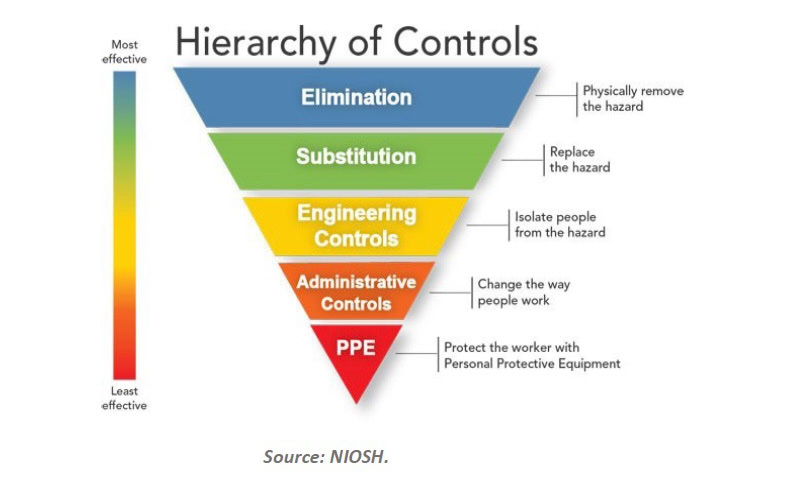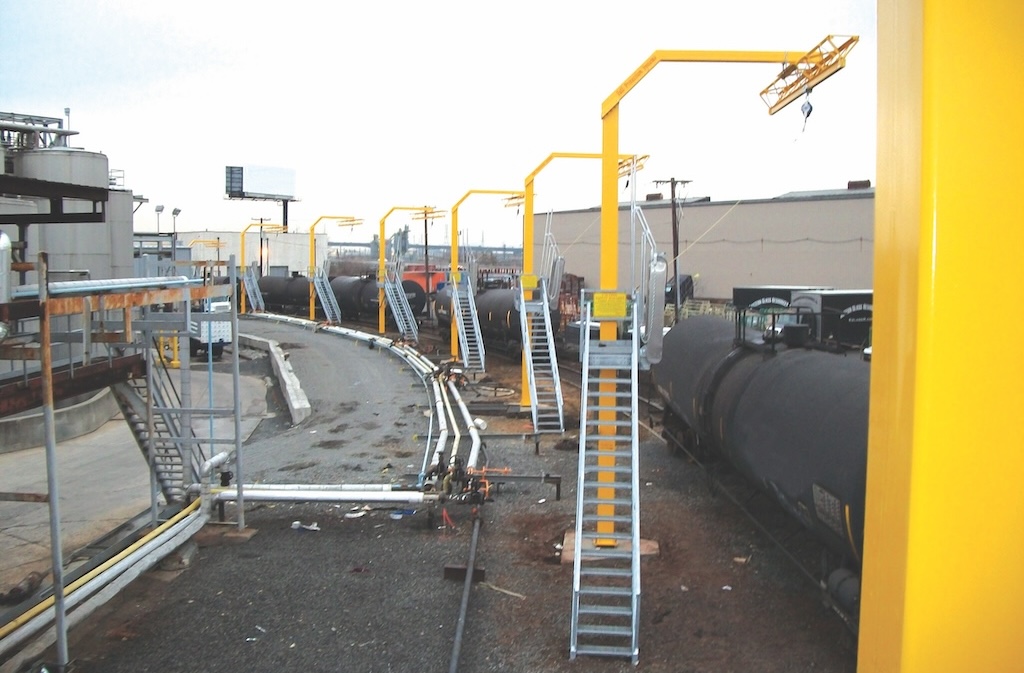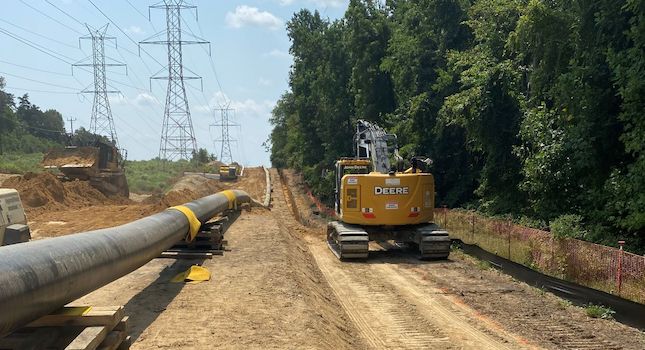Since ancient times, paint has been used to protect, decorate, and identify surfaces. It is also the number-one method of combating corrosion. The term coating is often used interchangeably with the word paint.
Since ancient times, paint has been used to protect, decorate, and identify surfaces. It is also the number-one method of combating corrosion. The term coating is often used interchangeably with the word paint.
Paint composition
Most paints consist of three basic components: pigment, resin (also called binder), and solvent.
Pigment provides properties such as color, hiding, corrosion inhibition, gloss control, sag resistance, and film thickness.
Pigments are organic or inorganic. Common examples are red and yellow iron oxide, titanium dioxide, and carbon black. Substances such as talc and clay are also used.
Corrosion inhibitive pigments are usually inorganic. Common examples are lead tetroxide (red lead), zinc chromate, zinc oxide, barium metaborate, and cement. These substances produce a surface passivating effect that interferes with corrosion of steel.
Resin is the component that binds the pigment together. The dry film is formed as the resin cures. The pigment and resin together contain the film-forming solids of a cured paint film.
Performance of a cured paint film depends heavily on the resin. Properties imparted by the resin include:
– Drying time
– Hardness
– Flexibility
– Chemical resistance
– Abrasion resistance.
Some common resins used for maintenance coatings are:
– Alkyd
– Acrylic
– Epoxy
– Polyurethane.
An important characteristic of resin is its curing mechanism (see “How resins cure”).
Solvent is incorporated to adjust the viscosity so that the painter can get the paint out of the can and onto the surface. No solvent remains in the dry film of a properly applied and cured coating. Resin and solvent components together are called the vehicle.
In addition to the pigment, resin, and solvent components, a small but important additional ingredient is the additive package. Although typically less than 2% by weight of the paint, additives such as these play significant roles.
– Antisettling agents increase shelf life by preventing pigments from settling into a hard cake in the bottom of the can.
– Adjusters for pH help prevent paint from attacking steel cans.
– Thixotropic agents cause the viscosity to rise sharply whenever the coating is not being worked. This condition is important for painting vertical surfaces and high film build.
– Defoamers prevent bubbles during manufacture and application.
– Driers are added to oil based/alkyd paints to accelerate the oxidation process.
– Mildewcides prevent mildew growth on paints such as latex and alkyd that contain natural ingredients.
– Antiskinning agents are antioxidants used to prevent skinning in the can.
– Pigment wetting agents are incorporated into paint formulas to assist the resin in surrounding and wetting dispersed pigment particles.
Surface preparation
Even though advances in formulation have produced coatings that are more surface tolerant, surface preparation remains crucial to a successful paint job. Inadequate or incorrect surface prep can shorten the life of a coating, sometimes drastically.
By far the largest cost element in a painting project is labor for preparation and application (see “Typical coating system costs” and “Preparation cost comparison”). Ironically, skimping on surface prep can result in major coating failure — a problem that has only expensive solutions.
Methods and degree of surface prep may also be strongly affected by several factors.
– Location — Factors such as accessibility or “7 x 24” operations in the work area can impose constraints.
– Surface type and condition — Steel may be new, rusted, or previously painted. Similar variations apply for masonry, wood, fiber-reinforced plastic, and nonferrous metals.
– Degree of cleanliness required by the coating system — This point includes both contamination found on the surface and contaminating residues left by some preparation methods.
– Surface profile required — Nature of the coating and substrate dictates how much of a “tooth pattern” is required for good adhesion.
– Environmental constraints — Airborne particulates, fumes, noise, and other aspects may be regulated by OSHA and EPA.
Steel
The Society for Protective Coatings — formerly the Steel Structures Painting Council and still known as the SSPC — is a valuable resource for information and training. It is the premier source of information related to painting steel.
SSPC publishes standards with visual references for preparing steel by means of solvents, hand tools, power tools, abrasive blasting, and high pressure water jetting.
Concrete and masonry
Painting cementitious surfaces is not usually difficult, but a successful job requires careful assessment of conditions. Moisture often hides in concrete. To check for moisture, cover an area at least 18-in. square with clear plastic sheeting. Use heavy gauge (4-mil) plastic, and seal the edges to the concrete with duct tape. If, after a couple of days, the area under the plastic becomes darker than the surrounding area, the concrete is too damp to paint.
Concrete surface conditions that can be the death of a paint job include laitance, efflorescence, dusting, and contamination with grease, dirt, oil, tar, or other substances. Preparation methods include machine or blast abrasion, acid etching, and wire brushing. SSPC publishes a standard for surface preparation of concrete.
Concrete floors can be particularly deceptive. Many a coating has been applied to an incorrectly prepared floor, only to fail badly in short order. Such a failure (blistering or sheet peeling) can be especially upsetting when the failed coating is a tough, high performance product, making it difficult and expensive to remove.
If painting projects are a regular item on the maintenance department agenda, a pressure washer should be part of the plant equipment. When not used for painting projects, the pressure washer can be put to numerous other uses.
Application
Both specifier and applicator must be knowledgeable about numerous application factors:
– Surface temperature
– Air temperature
– Humidity
– Wind speed
– Ventilation conditions
– Minimum and maximum recoat times
– Spreading rate
– Wet and dry film thickness
– Mixing and thinning
– Pot life of coating
– Appropriate application methods.
An application example of such knowledge is an understanding of the relationships between temperature, relative humidity, and dew point. Temperature of an abrasive blasted steel surface must not drop below the dew point before it is coated.
Equipment and people
When it comes to applying large quantities of paint, airless spray equipment is the hands-down winner in most situations. A common application rate is 1 qt/min/spray operator. With training, experience, and conscientious attitude, an airless spray operator can apply impressive amounts of paint and often do it better than by any other method.
The “people factor” is critical. Knowledge and diligence are key characteristics of a good painter. For example, airless spray equipment requires meticulous care if it is to perform reliably. In operation, the painter must be able to recognize (and care enough to rectify) problems such as inadequate or excessive pressure settings or worn or incorrectly sized spray nozzles.
A large assortment of application tools is available for smaller or specialized jobs. Rollers are offered in standard widths of 4, 7, 9, and 18 in. Commonly available nap lengths for roller covers range from 1/4 – 1 1/2 in. Special rollers are available for pipes and inside corners. “Slim Jim” rollers have a very small diameter and long, thin handle for reaching into narrow openings. Roller spinners allow easy cleaning and reuse of roller covers in many situations.
Brushes are available in an amazing variety of shapes, sizes, and bristle materials. For example, brushes can be purchased that have extra long handles and the business end bent at a 45-deg angle to the handle. A special brush holder attaches to the end of an extension pole for those occasional “impossible to reach” spots. Paint pads and mitts offer additional capabilities, and they’re disposable. The high cost of labor makes other disposable items such as paint pot liners attractive.
Inspection
Inspection of the application process and cured coatings is appropriate for large projects or smaller jobs where coating failure cannot be tolerated. The inspector can range from a hired consultant to even the painters themselves. While some may feel that having painters inspect their own work is like having a fox guard the chicken coop, a dedicated inplant paint crew with proper training and support may be motivated to deliver high-quality work.
There are several parameters that may need to be monitored:
– Ambient and surface conditions
– Compressor air quality (if blast cleaning)
– Surface preparation results, including profile
– Mixing, blending, and thinning of coating
– Wet film thickness
– Dry film thickness
– Recoat times
– Pinhole and holiday testing
– Adhesion testing.
Inhouse inspection may not be practical unless there is considerable ongoing painting activity. Checking the items in the preceding list requires an investment in equipment and training. In addition, some equipment requires periodic calibration.
Trends
The word painting may evoke a bucket-and-brush stereotype, such as railings being painted by a person temporarily assigned to light-duty work. In fact, field-applied coatings preserve huge investments in plant facilities and equipment, as well as beautifying and providing identification.
Traditionally, knowledge, skill, and experience of the specification writer and applicator form the basis of a successful paint job. That’s as true as it ever was, but two important trends are helping the maintenance manager and painter achieve better results at less cost.
Trend #1: Modern maintenance management techniques are being applied to painted surface maintenance.
The shift is from a reactive approach to one that is proactive and information based. There are several elements of a coating management program.
– Perform a site survey. Inventory surfaces and their conditions.
– Set priorities. Rank the inventoried surfaces according to their needs. This process helps avoid unnecessary work and extra costs due to jobs that are delayed too long.
– Set standards. Develop specifications for surface preparation and coating selection and application.
– Determine a budget. Some tradeoffs may be necessary between priorities, standards, and available funds.
– Implement the program. Update information continuously.
– Document results. As information accumulates, costs can be determined and allocated to reveal trends and make comparisons.
Software is available to ease the recordkeeping chore. Some software is rather sophisticated, providing surface condition indices and allowing inclusion of video clips and video or digital camera photos.
Trend #2: Chemists have vastly expanded the capabilities of coatings.
Tolerances for surface conditions and application environments have been improved far beyond those of traditional coatings. There are several new generation coatings.
– Surface-tolerant coatings that permit application directly to sound rusted metal. These coatings are typified by one-coat, high-solids epoxies.
– High and low-temperature curing coatings that enlarge the window of conditions suitable for application.
– Moisture-tolerant coatings that alleviate the old problem of trying to paint a perpetually damp surface.
– High-solids, or 100% solids coatings that have little or no solvent to evaporate.
– Water-based coatings such as dry fallout, direct-to-metal, and epoxies.
Plant Engineering magazine acknowledges with appreciation the helpful information provided by Rust-Oleum Corp., The Sherwin-Williams Co., and Tnemec Co. Inc.
How resins cure
Most resins cure by one of the five processes described below. It’s important to note that each process requires some minimum temperature in order to occur.
Evaporation — Also called lacquer curing, this process causes the paint film to dry simply by evaporation of the solvent. Maintenance coating examples are:
– Vinyls
– Chlorinated rubbers
– Coal tars.
Oxidation — After the solvent has evaporated, oxygen from the atmosphere causes a crosslinking (polymerization) reaction to occur in the resin.
Oxidation is one of the oldest curing mechanisms used; vegetable oils (basis for “oil-base” paints), such as linseed oil, cure by oxidation, but have long drying times. Alkyd technology, developed in the 1920s, provides faster drying times.
The amount of vegetable oil in an alkyd formulation is indicated by the designations short, medium, or long. Short oils dry the fastest, but long oils have the best surface wetting, flexibility, weatherability, and corrosion resistance.
Chemical — Also called co-reacting, chemical curing is the mechanism for two-component epoxies and polyurethanes. A chemical reaction between two different resin types produces high-density cured films with excellent hardness and resistance to abrasion, corrosion, and solvents.
Moisture — Some urethane resins cure by reacting with atmospheric moisture. They typically have excellent wetting and adhesion, even for marginally prepared surfaces.
Coalescence — Emulsion (“latex”) paints cure by this process. The film cures by evaporation of solvent (water is quite volatile) and coalescence of emulsified resin particles into a continuous film. Emulsion coatings perform well on concrete and similar surfaces, such as masonry block, plaster, and drywall. Special versions are formulated for direct-to-metal application.
Factors in coating selection
– Exposure conditions
– Surface preparation
– Application method
– Drying/curing conditions
Typical coating system costs
Labor, surface preparation 15-40%
Labor, application 30-60%
Labor, cleanup 5-10%
Tools and equipment 2-5%
Coating material 15-20%
Preparation cost comparison
Preparation Estimated Preparation, Application, Total cost, Net cost, method service, yr
Near-white metal blast 12.0 29 48 77 64
Commercial blast 10.5 27 48 75 71
Power/hand tool 7.5 22 48 70 93
Comparison of coating properties
Alkyds
Benefits:
Tolerate mild to moderate conditions
Minimal surface preparation
Apply by brush, roller, or spray
Few curing restrictions
Easy to use
Good general maintenance coating
Wide color selection
Limitations:
Not suitable for severe conditions
Fair exterior gloss retention
Not for galvanized metal or concrete
Fast dry with low VOC not possible
Polyurethanes
Benefits:
Resistance to severe conditions
Excellent exterior color and gloss retention
Tough, flexible film
Excellent chemical resistance
Limitations:
Limited pot life
Best appearance requires conventional spray
Not suitable for water immersion
Epoxies
Benefits:
Resistance to severe environment
Excellent chemical resistance
Excellent corrosion control
Suitable for water emersion
Can be formulated into mastics
Long service life
Limitations:
Poor exterior color and gloss retention
Limited pot life
Low-temperature curing restrictions
Limited recoat time
Water-based acrylics
Benefits:
Tolerate mild to moderate conditions
Fast dry with low VOC
Excellent exterior color and gloss retention
Suitable for galvanized metal and concrete
Apply by brush, roller, or spray
Limitations:
Substrate must be free of contamination, especially oil and grease
Temperature and humidity restrictions on application
Very high gloss not available
Coating calculations
Dry film thickness (DFT) of a paint film is of concern from the standpoints of both performance and cost. The volume of 1 gal. is 231 cu in. If 1 gal. of paint is spread at a uniform wet thickness of 1 mil (0.001 in.), it covers 1604 sq ft. The volatile components of the paint evaporate as it dries, leaving the solids contributed by the pigment and resin (film-forming solids). Paint specification sheets and containers commonly list the product’s percentage of film-forming solids.
Combining the preceding facts, the required spread rate for a given coating to yield a desired DFT is given by
Spread rate, sq ft/gal. = [% solids x 1604] / [specified DFT, mils]
For example, if a paint containing 50% solids is used to produce a DFT of 3 mils/coat, it must be applied at a spreading rate of 0.5 x 1604/3 = 267 sq ft/gal. The painter would check for a wet film thickness of 6 mils, because
Wet film thickness, mils = [DFT, mils] / [% solids]
For comparison purposes, material cost can be normalized:
Cost, $/mil-sq ft = [Cost, $/gal.] / [% solids x 1604]
Resources
There are several web sites available for additional information:
– SSPC: The Society for Protective Coatings (www.sspc.org)
– NACE: The National Association of Corrosion Engineers (www.nace.org)
– UMR Coatings Institute: The University of Missouri-Rolla (www.umr.edu/~coatings).
For more information related to this topic, see the “Paints and protective coatings” channel on www. plantengineering.com.



